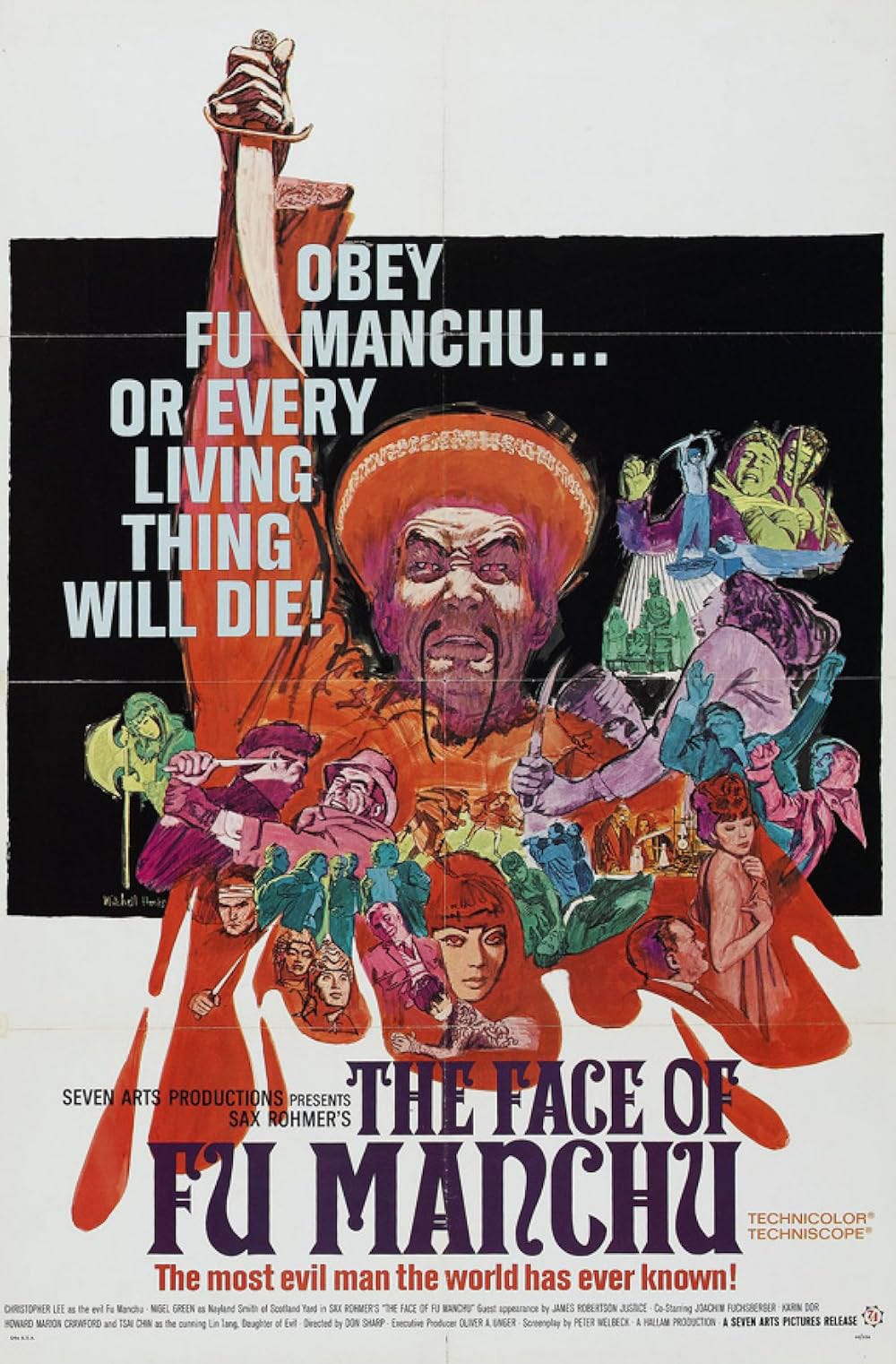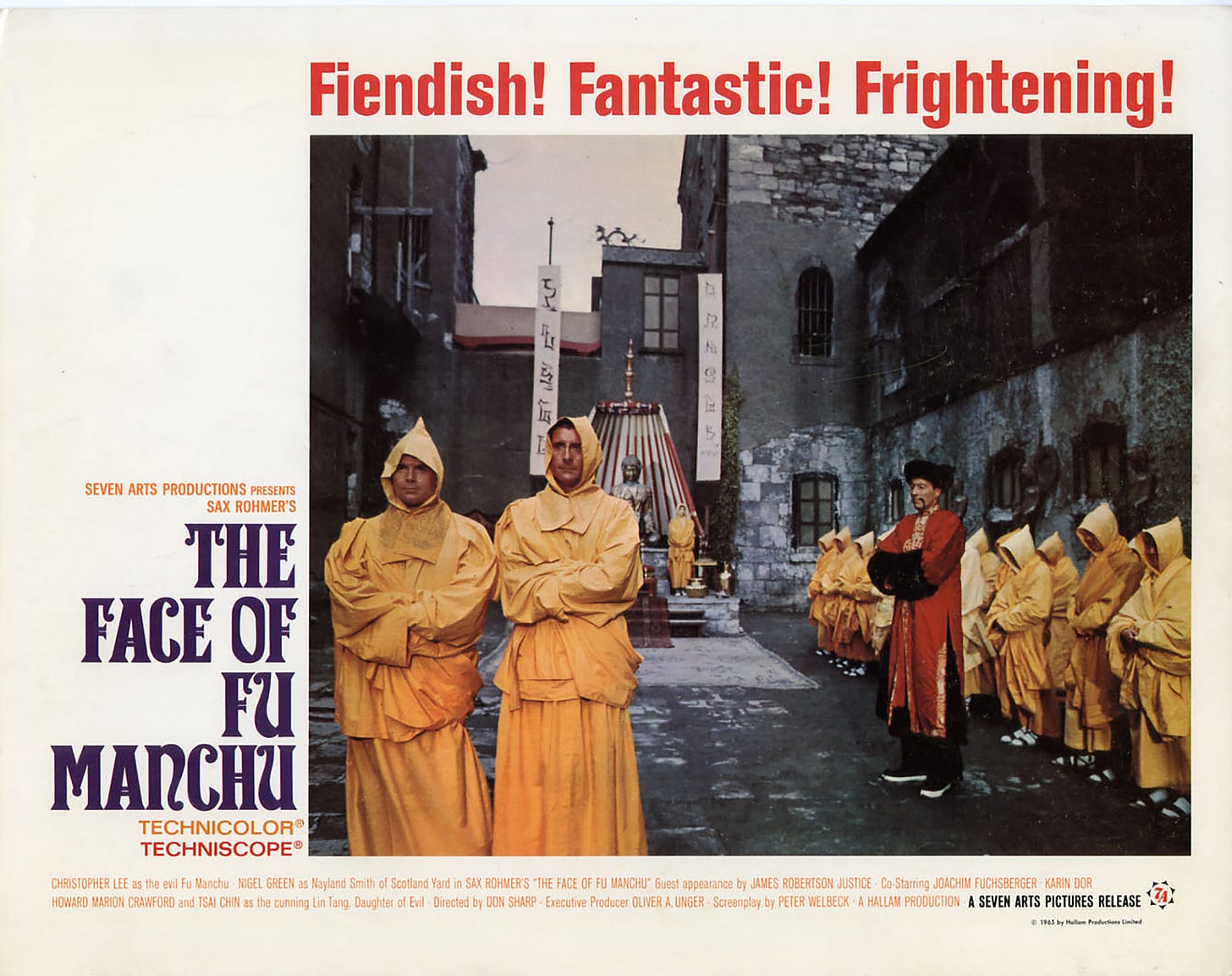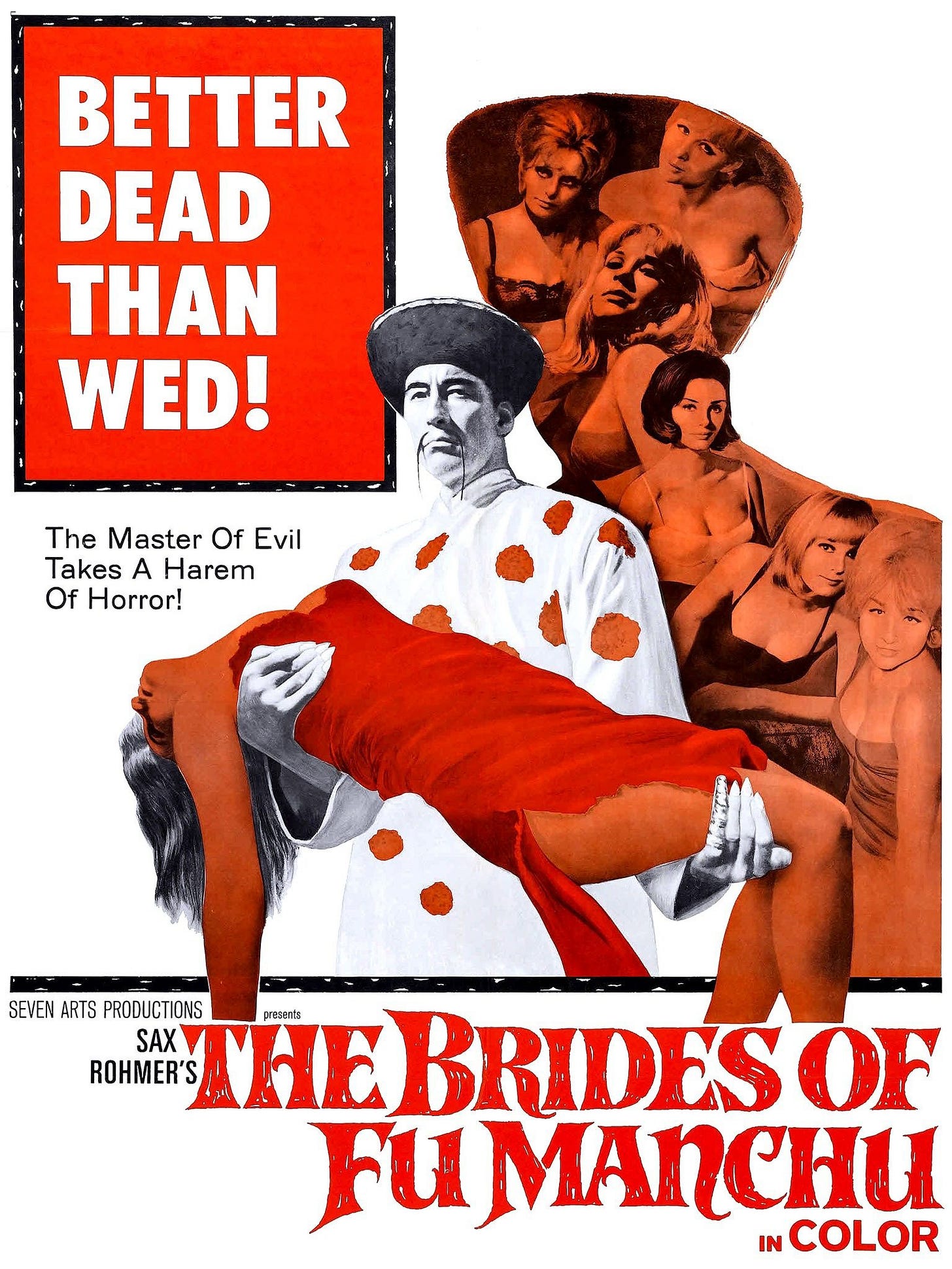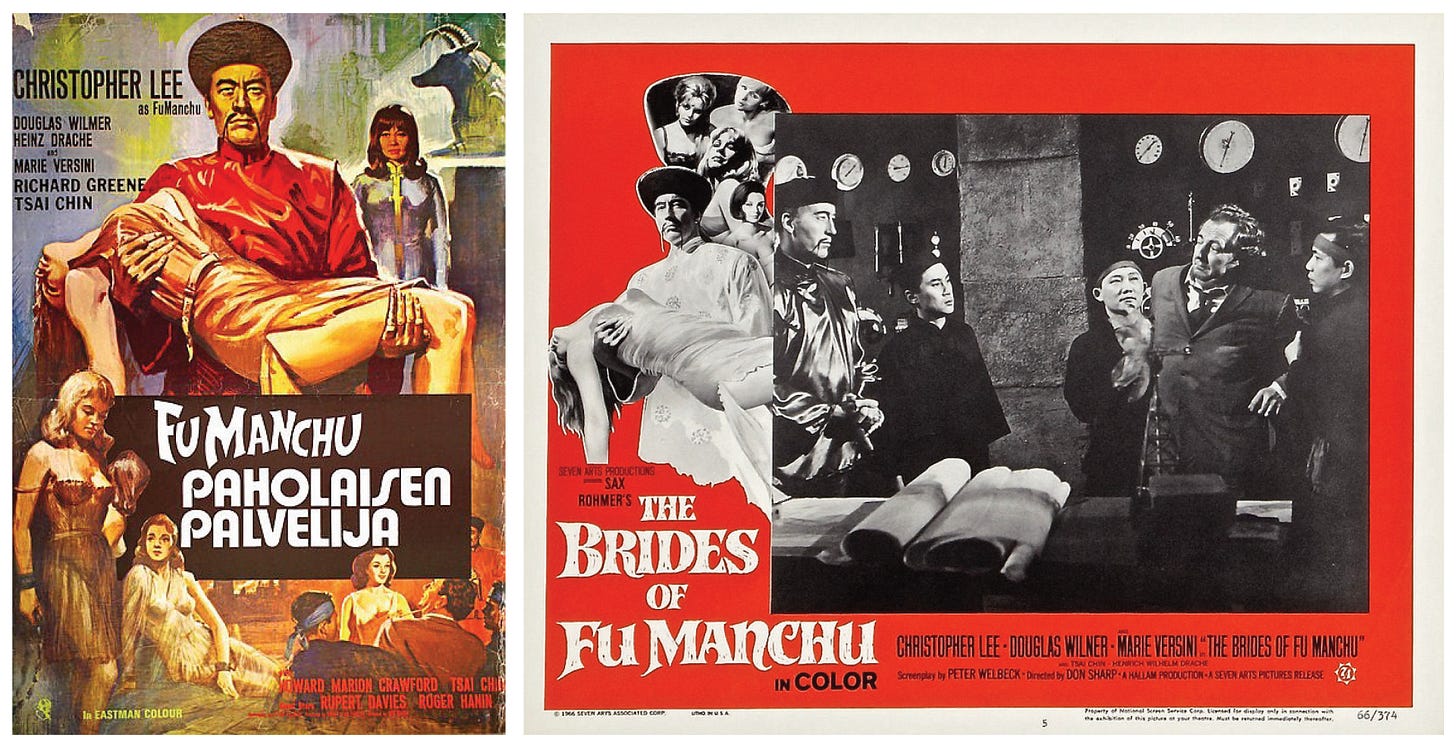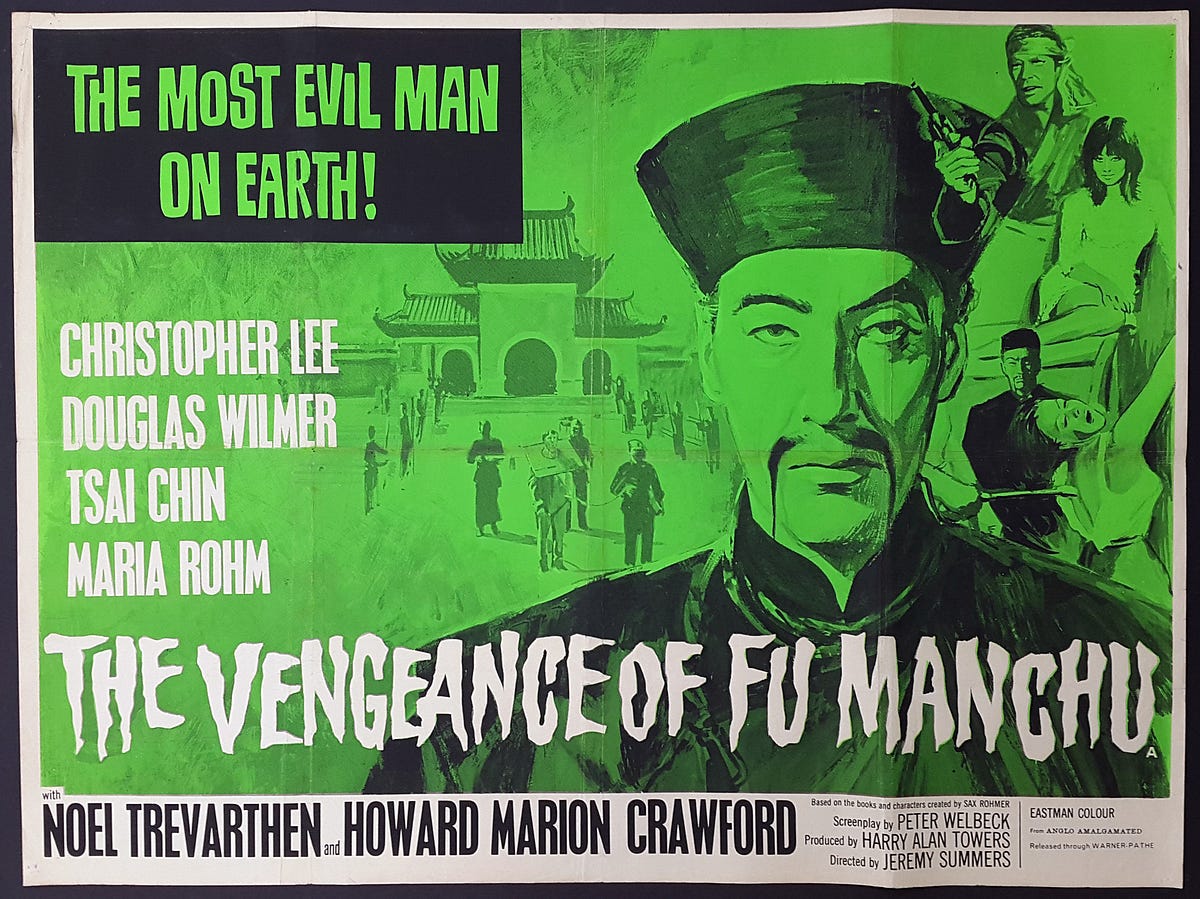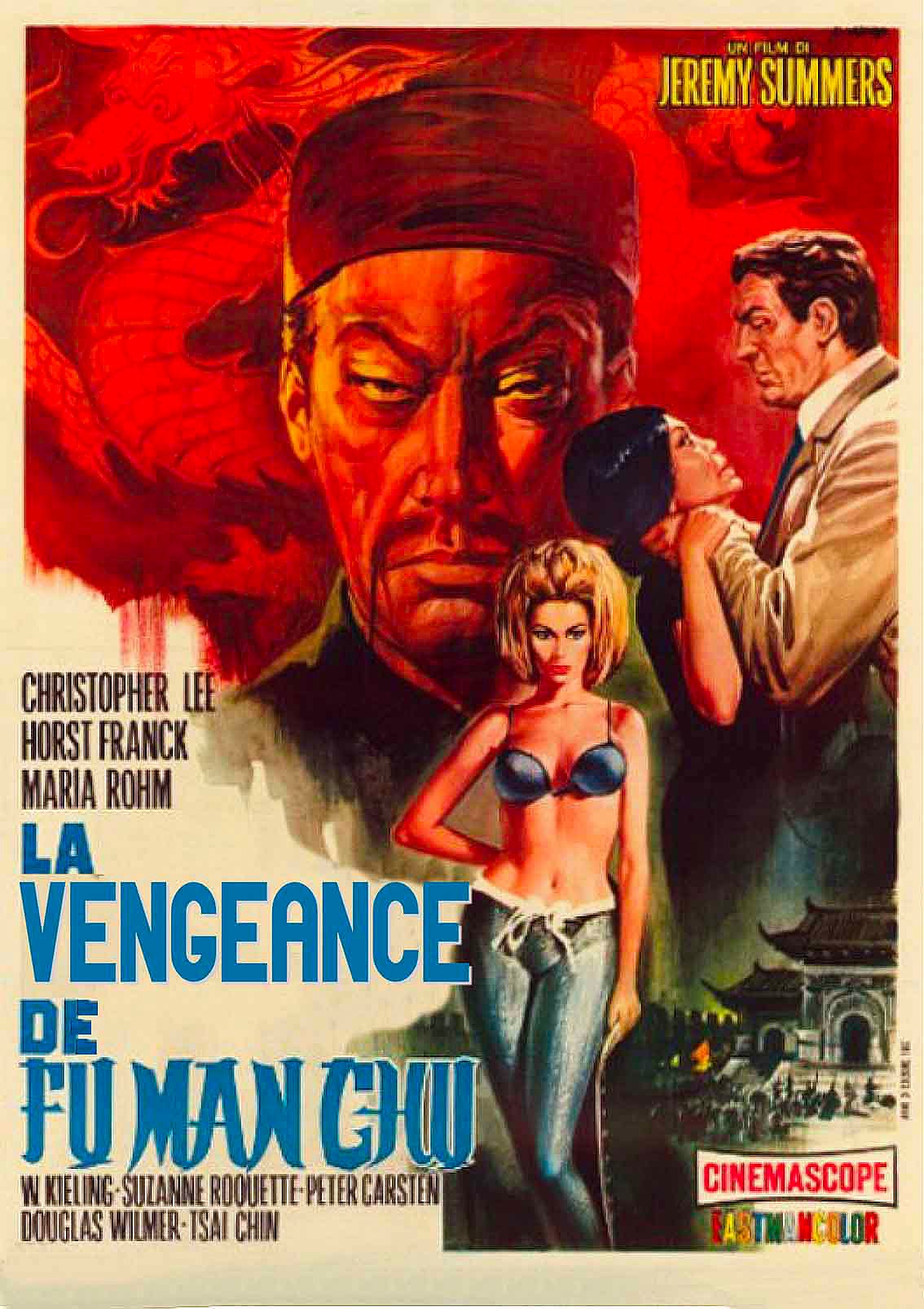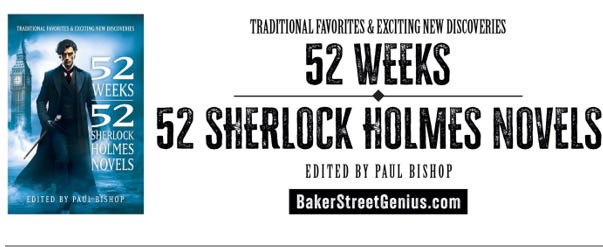This week, we dive into the darkest corners of pulp cinema as David Foster returns with the final installment of his Beyond Baker Street series—this time examining the Christopher Lee era of Fu Manchu films. From ritualistic executions to snake pits and hypnotized daughters, Foster peels back the layers of these infamous mid-century thrillers with sharp wit and a historian’s eye. With three international co-productions on the table (The Face of Fu Manchu, The Brides of Fu Manchu, The Vengeance of Fu Manchu), Foster explores how Lee’s sinister gravitas couldn’t quite save a series slowly sinking into B-movie obscurity.
Beyond Baker Street VII
“Cruel, Callous, Brilliant and the most Evil Man in the World!”
Christoper Lee as Fu Manchu
G’day friends. Welcome to the fourth instalment of this series on the nefarious Doctor Fu Manchu. It’s a little longer than usual. This time around, I’m turning my attention to the first three films in the Christopher Lee era, beginning with The Face of Fu Manchu (1965), followed by The Brides of Fu Manchu (1966) and The Vengeance of Fu Manchu (1967). All three were international co-productions that tried—sometimes awkwardly—to balance pulp thrills with an air of exotic menace. Lee, towering and grave, brought a certain icy gravitas to the role, but even he couldn’t quite elevate the material above its problematic roots.
Now, before you ask—no, I won’t be subjecting you (or myself) to a detailed review of the fourth and fifth entries in the series, The Blood of Fu Manchu (1968) and The Castle of Fu Manchu (1969). Both were directed by Jess Franco, and let’s just say they’ve aged like milk on a windowsill in summer. I’ll spare you the ignominy. You’re welcome.
The Face of Fu Manchu (1965) was the first of five films that producer Harry Alan Towers (and his alter ego, screenwriter Peter Welbeck) made featuring Sax Rohmer’s character Fu Manchu. Out of all five, this is the only one that is quite good. Maybe that is on the strength of Nigel Green as Nayland Smith of Scotland Yard, Fu Manchu’s archenemy. Green only appeared in this film. Douglas Wilmer portrayed him in the next two films, and for the final instalments, Richard Greene took over the mantle. At least the villains were consistent. Christopher Lee played Fu Manchu and Tsai Chin appeared as Fu Manchu’s malevolent daughter Lin Tang for all the five films in the series.
The film opens in China. We are in a prison courtyard and an execution is taking place. The man to be executed is Fu Manchu. On hand to witness the execution is Nayland Smith of Scotland Yard. Fu Manchu is marched to a chopping block, and with a lusty blow from a scimitar, his head is cleaved from his body.
Afterwards, Nayland Smith is back in London, and he has landed a cushy desk job, which he is not happy about. He is sure that the “Crime Wave” sweeping Europe is the work of one criminal mastermind. But none of his superiors want to hear about it. The only person who has time for Nayland Smith’s theories is Dr. Petrie (Howard Marion Crawford). For the uninitiated, Dr. Petrie is to Nayland Smith, what Watson is to Sherlock Holmes.
Then we are introduced to Professor Hans Müller (Walter Rilla) and his young assistant. In a pea-soup fog they turn up at an old church in Limehouse. They enter the grounds of the “apparently” deserted church. The assistant is strangled as he wanders through the yard. The Professor was told to come on his own. He is taken inside. And who is behind all this? The still very much alive Fu Manchu.
The next day, the Professor’s assistant’s dead body is found. Around his neck is a red prayer scarf, with a medallion of the Goddess Kali tied into one of the corners. Naturally enough, Nayland Smith has seen all this before. It is the work of Burmese Dacoits. They believe the act of murder is blessed by the Goddess Kali, and every ritual killing is a passport to heaven. But the Dacoits must have someone controlling them, and even though he knows it is impossible, after all he saw the man executed, Nayland Smith believes that Fu Manchu is the man behind the killing. He plans to visit Professor Müller an ask him some questions.
At Professor Müller’s home, his daughter, Maria (Karin Dor) waits for his return. As she waits a Dacoit pays her a visit. She screams. At that moment Karl Janssen (Joachim Fuchsberger), Professor Müller’s research partner, arrives and rushes to her aid. By this time the Dacoit has disappeared but has left behind a message:
“If you value your father’s life —
say nothing of his disappearance.”
Suddenly there’s a noise in the laboratory downstairs. Janssen rushes down to investigate and gets into a noisy fistfight with Nigel Green’s stunt double (who’s silhouette looks nothing like Green). Before they kill each other, Maria rushes down and turns on the light, and the men stop.
But why is Fu Manchu interested in Professor Müller? Professor Müller had previously studied in Tibet. His research brought him in contact with a flower called the Black Hill Poppy. The flower is incredibly rare, and the Professor needs it for his research. The Professor had received a letter two days previously, saying that if he went to the old church in Limehouse he would be given some special supplies. Naturally the Professor went, and he was captured by Fu Manchu. Fu Manchu knows that a powerful poison can be manufactured from the Black Hill Poppy. A poison so strong that one-pint would kill everyone in London. A sure enough, that is exactly what evil mastermind Fu Manchu would like to get his hands on.
Nigel Green is one of the great character actors of his time, adding weight and class to a myriad of productions. Notable performances include Zulu, The IPCRESS File, Deadlier Than the Male, and The Wrecking Crew. He also did quite a bit of television work, appearing in shows such as Danger Man, The Avengers and The Persuaders. His portrayal of Nayland Smith is the best in the Fu Manchu series, and it is a shame that he only appeared in this film.
The Face of Fu Manchu is quite a good film. Its reputation is somewhat tarnished by the lesser films in the series, but as a stand-alone movie, this works extremely well as a period thriller.
The Brides of Fu Manchu (1966) is the second Fu Manchu film written and produced by Harry Alan Towers. It features Christopher Lee and Heinz Drache who had appeared in Towers’ production of Circus of Fear the previous year. It’s almost as if Towers had his own little repertoire company.
The film opens with a trio of Fu Manchu’s black clothed minions leading French Professor Merlin (Rupert Davies), who is blindfolded, through a series of caves and then into a large underground chamber. Once inside, his blindfold is removed. He appears to be some Egyptian temple decorated with deities and Hieroglyphs. Down each side of the temple run rows of massive stone pillars, and chained to each of these pillars is a beautiful girl. As Merlin is led through the temple towards an alter at the front, he recognises one of the captive girls as his own daughter, Michelle.
At that moment, Fu Manchu (Christopher Lee) and his daughter, Lin Tang (Tsai Chin), enter the chamber. It is revealed that Professor Merlin is an expert in radio transmission, and Fu Manchu demands that the professor works on a special project for him. Merlin’s response is simple and to the point: “Go to Hell!”
Then Lin Tang has Michelle freed from her shackles and brought before her. It appears that over the duration of her captivity, Michelle has been brainwashed. Lin Tan gives her a knife. First, she is told to hold it at her father’s throat, which she does. Realising that Fu Manchu needs his expertise, Merlin calls Fu Manchu’s bluff and suggests that he cannot be killed. Fu Manchu agrees and adopts another strategy to coerce the professor. One of the other captive women is unchained from a pillar and brought to a giant stone tablet. The girl is tied by her hair to two metal rings embedded in the tablet. Then, a sliding stone trapdoor is released under the tablet and beneath is a pit of venomous snakes.
Fu Manchu then gives Michelle the order—not to kill the girl—but simply to cut her “free.” Michelle obeys and the other girl falls to her death in the pit of snakes.
Professor Merlin is told that unless he co-operates, Michelle will be brought out of her hypnotic trance and made to face the consequences of her murderous act.
Meanwhile in London, Dennis Nayland Smith (Douglas Wilmer) is trying to unravel the mystery of the disappearance of the wives and daughters of many of the world’s leading industrialists and scientists. So far eleven women have been abducted in the last eighteen months—from ten different countries.
Strolling casually along the Thames is Research Chemist Hans Baumer (Heinz Drache) with his lovely companion Marie Lentz (Marie Versini). Suddenly, a team of Fu Manchu’s Dacoits attack, attempting to kidnap Baumer. However, Baumer is pretty good with his fists and fights off the attack.
As the information on the attack is relayed to Nayland Smith, later, do they realise that the Dacoits weren’t after Baumer at all, but after Marie, who is the daughter of Hydro-electric specialist Otto Lenz. Marie works in a hospital, and a second team of Dacoits arrive to kidnap her while she is on duty. Thankfully, Nayland Smith arrives just in the nick of time to fight of the kidnappers.
Nayland Smith suspects Fu Manchu is behind the abduction and attempts to find a lead. Unfortunately, his only lead is Marie, and finally Fu Manchu’s minions manage to kidnap her on their third attempt. But Baumer has a plan. If Fu Manchu has been using these girls to coerce the scientists and industrialists to do Fu Manchu’s work, that it would follow suit, that Marie’s kidnapping would work in the same way. So Baumer impersonates Otto Lentz so he can infiltrate Fu Manchu’s organisation.
Also working on the case is a French inspector Pierre Grimaldi, played by Roger Hanin, who helps Nayland Smith put together the pieces of Fu Manchu’s scheme, which uses radio waves as a method of carrying large amounts of energy, which can be used for destructive purposes. And that is just what Fu Manchu has in mind. His plan starts with the destruction of the Windsor Castle and ends with total world domination.
Fu Manchu’s radio transmitter tower, in the way it looks and operates, bears more than a passing resemblance to the solar dish in The Man with the Golden Gun, which also starred Christopher Lee although made eight years later.
The Fu Manchu films are perfect examples of the law of diminishing returns. I found the first film, The Face of Fu Manchu, to be quite a good little adventure. This film is a small step down from the earlier outing but is still very entertaining, but each instalment is weaker than the previous outing, and after the third film, the piss-poor plots and shoe-string budgets were below acceptable standard, and the films have little to recommend them beyond the presence of Christopher Lee.
The Vengeance of Fu Manchu (1967) is the third in the Harry Alan Towers produced Fu Manchu series. With each instalment, the quality of the series dropped considerably. This film has a few too many long-protracted moments where not too much happens and on the odd occasion when something is happening, you don’t really care about the outcome. All I can say is that it is better than the next two instalment in the series.
Douglas Wilmer once again plays Fu Manchu’s Nemesis Nayland Smith, which he did previously in The Brides of Fu Manchu. Wilmer is adequate in the role, displaying a squared jawed heroic countenance, but he doesn’t have the screen presence of Nigel Greene who played the character in the first film.
Of course, you can’t talk about a Fu Manchu film without talking about horror icon Christopher Lee. By this film in the series Lee looks quite bored by the role. He isn’t given too much to say. He simply has to glower and nod his head, and his evil minions do the work for him. I guess it is in keeping with the character, but it isn’t particularly a stretch for Lee.
The film begins in the Quang-Su Provence in Northern China, and along a winding mountain track a small caravan of men make their way to a hidden fortress. Riding in comfort in two carriages, carried by their evil minions are the most evil man on earth, Fu Manchu and his equally vicious daughter Lin Tang (Tsai Chin).
Once at the fortress, Fu Manchu has all the paths and roadways dynamited, cutting off the outside world, so he can formulate his attempt to take over the world in relative peace.
In London, Commissioner Nayland Smith of Scotland Yard is planning a trip to Paris. He’s meeting other police chiefs to set up a new organisation designed to battle international crime. This new organisation is to be called “Interpol.” At this meeting is a young FBI agent, Mark Weston (Noel Trevarthen). He reports that the crime gangs of America have selected a man named Rudolph Moss (Horst Frank) to be their new ambassador and seek out a new “head” of global crime. You’ve got to remember here, that everybody thinks that Fu Manchu is still dead. he died at the end of the last film. So, the FBI and Interpol don’t know who this new “head” will be. Of course, we viewers know it is going to be Fu.
Meanwhile back in China, Fu Manchu is putting his latest plan into operation. First, he kidnaps Dr. Lieberson (Wolfgang Kieling) and his daughter, Maria (Susanne Roquette) from a nearby village. Lieberson initially refuses to work for Fu Manchu, so his daughter is tortured. Soon after the doctor relents. The doctor is given a mission is to transform one of Fu Manchu’s Asian minions into a Caucasian likeness of Nayland Smith. And Fu instructs that this must be done in forty-eight hours. I think a modern-day plastic surgeon would have trouble completing that task, let alone a doctor in a remote village in Northern China. But who knows, maybe the doctor is really a “Super Doctor” who really believes in doing humanitarian work, rather than living at the cutting edge of medical science. I know, it’s silly of me to pick on the medical and scientific plot devices in a Fu Manchu film. But I cannot help it. Regardless, the doctor, fearing for his daughter’s life, agrees to transform Fu Manchu’s mindless killer into Nayland Smith.
Interpol is busy tracking down Rudolph Moss. It seems he was bound for Shanghai on a ship called the Orient Star. Interpol wires Inspector Ramos (Tony Ferrer) of the Shanghai Police Department. Ramos intercepts the ship, but he is too late. Moss has already disembarked and his heading across the country to meet Fu Manchu.
Meanwhile, Nayland Smith and his close friend Dr. Petrie (Howard Marion-Crawford) are off on holiday in Ireland. On a rural track, their car runs out of petrol. luckily a car comes along, and Petrie hitches a lift into the nearest village to fill up a can of fuel. By the time Petrie returns, Nayland Smith has been kidnapped and Doctor Lieberson’s psychotic double has been put in his place. The real Nayland Smith is bound and gagged and sealed in a wooden crate bound for Shanghai.
I don’t rate this entry in the Fu Manchu series very highly, but it does have a few points of interest. First, for spy fans it is worth noting that Tony Ferrer, who plays Inspector Ramos in the film, was a big star in the Philippines. One of his higher profile series was the Agent 44 Tony Falcon films made in the ‘60s, ‘70s and ‘80s.
Second, this film was a co-production with Hong Kong’s Shaw Studios, which means it has a slightly different flavour to the other entries in the series. In the end though, despite the international intervention, this film is a step down from previous films, and it really should have been the end of the series. But the Devil Doctor Fu Manchu kicked on for another two films, each with a diminishing budget, and helmed by Jess Franco.
“You can read my thoughts on when Sherlock Holmes met Fu Manchu in Cay Van Ash’s Ten Years Beyond Baker Street in 52 Weeks, 52 Sherlock Holmes Novels— a multi-personal look at fifty-two of the best Sherlockian pastiches—edited and collated by Paul Bishop.”
Beyond Baker Street
I’ve always been fascinated by the shadow cast by Sherlock Holmes—a figure so iconic that his influence seeps into unexpected corners of pop culture. Beyond Baker Street is where I chase those echoes. Whether it’s a villain who once faced Holmes or a story that feels like it should’ve, this series lets me explore the strange tributaries that flow from the great detective’s world.
If you’ve enjoyed this piece, you’ll find even more to explore in my book Baker Street: The Curious Case Files of Sherlock Holmes—a deep dive into 100+ years of Sherlock Holmes in print, film, television, and beyond. From Conan Doyle’s original stories to pastiches, parodies, and pop culture echoes, it’s a must-read for Holmes fans and curious minds alike.
Yours in the Spirit of Adventure
David Foster is an Australian best-selling author who writes under the pen names James Hopwood, A.W. Hart, and Jack Tunney. Under the latter, he has contributed three titles to the popular Fight Card series. His short fiction has been published in over 50 publications worldwide, including by Clan Destine Press, Wolfpack Publishing, and Pro Se Productions, to name but a few. In 2015, he contributed to the multi-award-winning anthology Legends of New Pulp Fiction, published by Airship 27 Publishing.
Foster’s non-fiction work appeared in the award-winning Crime Factory Magazine, as well as contributing numerous articles exploring pulp fiction in popular culture to Girl Gangs, Biker Boys, and Real Cool Cats: Pulp Fiction and Youth Culture, 1950 to 1980 (2017, PM Press) and Sticking It to The Man: Revolution and Counterculture in Pulp and Popular Fiction, 1950 to 1980 (2019, PM Press). He has also contributed articles on the ANZAC war experience to Remembrance (2024, Union Street 21).
Foster lives in the old Pentridge Prison Complex, behind high grey stone walls, in inner-suburban Melbourne, Australia.
Ready to continue the adventure? Get Baker Street today
Next check out 52 Weeks - 52 Sherlock Holmes Novels


